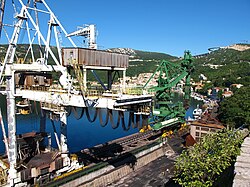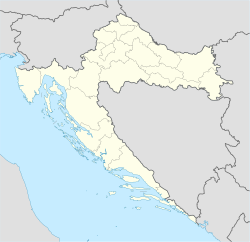Bakar | |
|---|---|
| Grad Bakar Town of Bakar | |
| Coordinates: 45°19′40″N14°32′10″E / 45.32778°N 14.53611°E | |
| Country | |
| Region | Central Croatia (Croatian Littoral) |
| County | |
| Settled | 1st century |
| Named | 1288 |
| Free city | May 13, 1798 |
| Royal Borough | April 23, 1799 |
| Government | |
| • Mayor | Tomislav Klarić (HDZ) |
| • City Council | 15 members [1] |
| Area | |
| 125.5 km2 (48.5 sq mi) | |
| • Urban | 3.0 km2 (1.2 sq mi) |
| Population (2021) [3] | |
| 7,573 | |
| • Density | 60.34/km2 (156.3/sq mi) |
| • Urban | 1,187 |
| • Urban density | 400/km2 (1,000/sq mi) |
| Time zone | UTC+1 (CET) |
| • Summer (DST) | UTC+2 (CEST) |
| Area code | 051 |
| Website | bakar |
Bakar is a town in the Primorje-Gorski Kotar County in western Croatia. The population of the town was 8,279 according to the 2011 Croatian census, including 1,473 in the titular settlement. [4] Ninety percent of the population declared themselves Croats by ethnicity. The largest ethnic minority are the Serbs with 2.91% of the population. The old part of Bakar is situated on a hill overlooking the Bay of Bakar. Bakar is the Croatian word for "copper".
Contents
- Settlements
- Climate
- Demographics
- Coat of arms
- Recognizable buildings
- History
- World War I
- Kingdom of Yugoslavia
- World War II
- Recent
- Trivia
- References
- Bibliography
- Dialectology
- History 2
- External links
Bakar is a port for bulk cargo and used to be known for its industrial complex that included a coke factory, which produced a considerable amount of pollution. Bakar's coke factory was closed in 1995 and the area's pollution has subsided significantly. The historical core of Bakar was registered as a cultural monument in 1968. [5]














